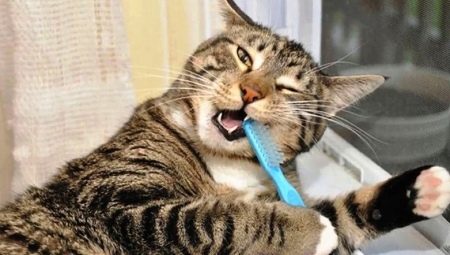How to brush your cat's teeth at home?

Having decided to have a cat at home, a person takes responsibility for his life. In addition to creating comfortable conditions for living and feeding the animal, constant care is needed for it. Particular attention should be paid to the teeth of cats, which need to be brushed periodically. Otherwise, your pet may develop serious oral problems. How to properly brush a cat's teeth at home will be discussed in this article.
How often should you brush your teeth?
Cats are among those animals that independently take care of their hygiene. However, this does not mean that pets do not need extra care. Cats, like humans, can have oral problems, which are most often associated with improper dental care.

In their natural habitat, all felines are forced to independently obtain food and hunt for themselves. Wild animals often have to eat solid foods and gnaw bones.
Thus, cats regularly clean their tooth enamel, preventing salt deposits on it and removing food debris.
Domesticated individuals often feed on soft food and are unable to remove plaque from the canines. Pieces of food may also remain in the oral cavity, salt deposits may appear. Over time, stones form in the areas adjacent to the gums.

In advanced cases, bacteria spread to soft tissues, an unpleasant odor appears from the mouth. The gums become inflamed at first and may bleed later. If you do not take measures to treat your pet in time, then his teeth will begin to fall out. To avoid these health problems for your pet, it is better to take care of the condition of his teeth in advance.
If the animal's oral cavity has not been cared for for a long time, and problems with the enamel or gums have already begun to appear, you should contact your veterinarian. In this case, specialized cleaning at the veterinary clinic may be required.

Generally, cats do not need to clean their mouths daily. It is enough to carry out the enamel cleaning procedure at least once a week. However, in some cases, your pet's teeth will require more thorough and frequent care.
If your pet predominantly eats canned cat food and other soft foods, then brushing your teeth is best done three to five times a day. Due to improper procedure or the use of ineffective products, the animal may develop bad breath or plaque on the enamel. In this case, you need to start brushing your cat's teeth more often and more thoroughly.
Small kittens do not need to clean their mouths, as they retain milk teeth until the age of 3-5 months. However, during this period, you can gradually accustom the animals to cleaning. You can start with a simple massage of the gums, and then move on to "acquaintance" of the animal with the brush.

Required tools and tools
There are several different ways to clean the mouth of cats. Depending on the technique used, the right tools and means are selected. The standard set for the procedure is a special brush and toothpaste or gel.

You can purchase the necessary tools at pet stores. Brushes can vary in size and shape. There are special massage and bristle fingertips. However, this method is unsafe, since not all cats will allow fingers to touch their teeth, they may even bite.

It is allowed to use a toothbrush for children, as it has a soft bristle and will not damage the cat's gums. As an alternative cleaning method, take a piece of soft cloth and wrap it around your index finger.
As for toothpastes for cats, unlike toothbrushes they cannot be replaced by human means. This is due to the fact that animals do not spit out the paste and do not rinse their mouth after it. Therefore, products for humans can harm the cat, even lead to poisoning.
At pet stores and veterinary clinics, you can find pasta that has a variety of food flavors such as meat and fish. The taste can attract the animal, making it easier to clean the enamel. Some cats strongly dislike the mechanical method of enamel cleaning.

In this case, you can purchase special liquid... It is bred in water, which is given to the pet to drink. The composition of the product includes special components that allow you to remove plaque from the teeth and cleanse the oral cavity from bacteria. It is also recommended to include more solid foods in the animal's menu.
From time to time, you can let your pet chew on chicken bones. Pet stores sell specialty treats that help remove plaque from tooth enamel, such as chewing sticks.

Hard or sharp objects, such as toothpicks, should not be used to clean the oral cavity, as they can injure the animal.
Carrying out the procedure
Before you start regularly brushing your animal's teeth, it is advisable to prepare it for this procedure. Otherwise, the cat may react aggressively to attempts to put a foreign object in its mouth. If your pet's enamel is going to be cleaned with a special fingertip or a piece of soft cloth, it is important that he gets used to the owner's finger in his mouth.
You can start training with a gentle massage of the gums. You can also smear your finger with something tasty and attractive to your pet, and let him lick the skin. If toothpaste and a brush will be used for cleaning, then you must give the cat a preliminary acquaintance with these items.
Let your pet sniff the brush and nibble on the stubble. Squeeze out some toothpaste from the tube and let the cat taste the composition. If the animal refuses to lick the product on its own, then a small amount of the paste is applied to the tip of the nose. Thus, the cat will be able to taste and appreciate the taste of the composition.

If your pet likes the tube mix, you can apply a small amount to the toothbrush and let the pet lick it. Before starting to cleanse the entire oral cavity, it is recommended to start accustoming the cat to the procedure, periodically applying the paste to the front teeth.
Cleansing a cat's mouth may seem daunting at first glance. If you follow the basic recommendations and gradually accustom the animal to this procedure, then there will be no difficulties in the cleaning process.
For the first time, you can use cotton swabs to clean the enamel, as not all cats quickly get used to a toothbrush.

Before starting the procedure, it is important to make sure that the animal is in good spirits and not under stress. But it is also important that the cat is healthy and well-fed. It is not recommended to disturb your pet during sleep and deliberately wake him up just for the sake of brushing his teeth.
The cat must be fixed in a comfortable position. It is most convenient if the animal has its back to the owner., since in case of resistance, the pet will begin to push and move back. It is advisable to partially restrict the pet in the possibilities of movement, for example, by squeezing it between the legs or swaddling it in a sheet.
Carrying out such manipulations, one should remember about the safety of the cat. In no case should the animal be strongly squeezed.... Before you start cleaning, a small amount of paste is squeezed onto the toothbrush. Next, you need to take the pet by the head.
It is most convenient to do this from above, pressing your ears with your palm, and place your index finger in the corner of your mouth. This will make it easier to lock the jaw in the open position. Brushing begins with the front teeth, brushing them up and down.

Do not forget that you need to clean not only the outer side of the teeth, but also the inner one. After brushing the front canines, you need to pull the pet's cheek on one side and work on the back teeth. Then the procedure is repeated with the opposite side. All movements must be careful so as not to harm the animal.
In total, the procedure takes less than one minute, but the first time it may take longer.
Veterinarian advice
One of the common mistakes cats make when brushing their teeth is rushing. Each animal may react differently to this procedure. Some individuals quickly get used to cleaning the mouth strip, while others will take more time. Impatience and assertiveness can only scare the pet or cause him to be irritated and aggressive.

Even if the pet calmly tolerates brushing its teeth, for him this process is most often stressful, especially at first. So that the cat does not hold any grudge against the owner, after the manipulations done, it is recommended to pamper the animal with his favorite delicacy.
In addition to rewarding it with delicious food, you need to soothe your pet by stroking it. It is best to establish a clear schedule for the procedures, as this will help the cat get used to them faster.
If several cats live in the house, then each animal should have its own toothbrush.

It is recommended that you visit your veterinarian before starting to regularly clean your cat's tooth enamel. The doctor will be able to assess the condition of the animal's oral cavity and give basic recommendations for the procedure and the choice of the necessary funds. In case of dental problems, the doctor will conduct a professional cleaning in the clinic.
Some cat owners resort to using non-standard products for cleaning their cat's teeth. For example, soda and wine or hydrogen peroxide.This method of cleaning the oral cavity cannot be called absolutely safe for the pet. If used improperly, such products can negatively affect the condition of the gums and the health of the cat.
For information on how to brush a cat's teeth at home, see the next video.
































